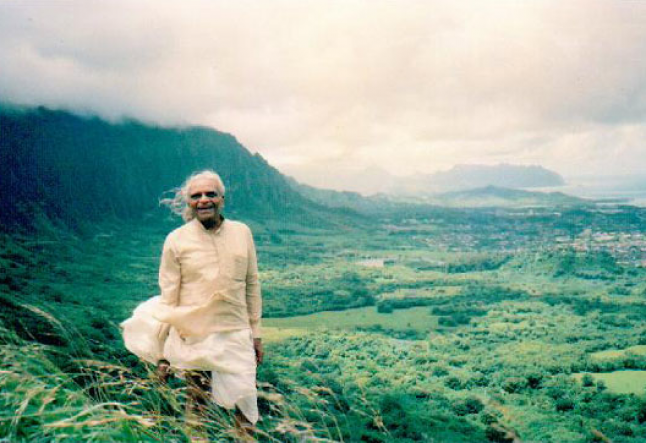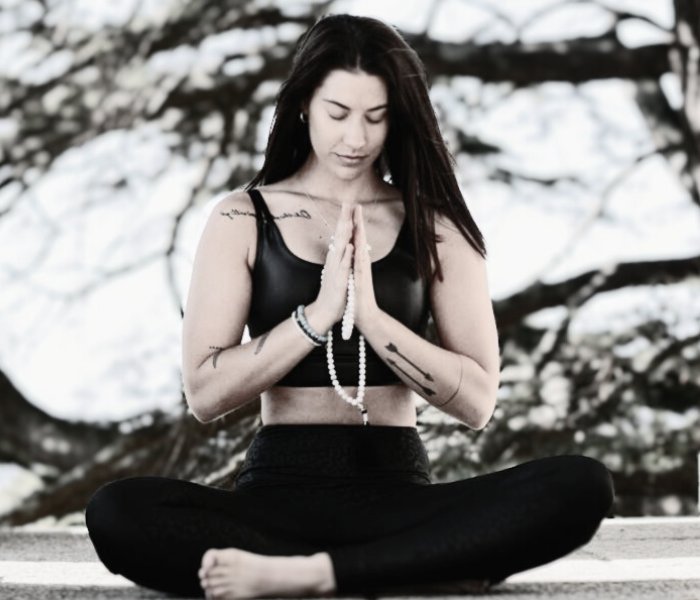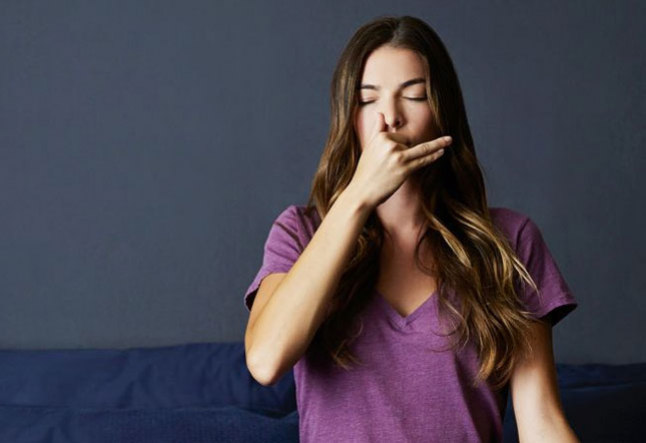how yoga prepared me for hip replacement surgeries
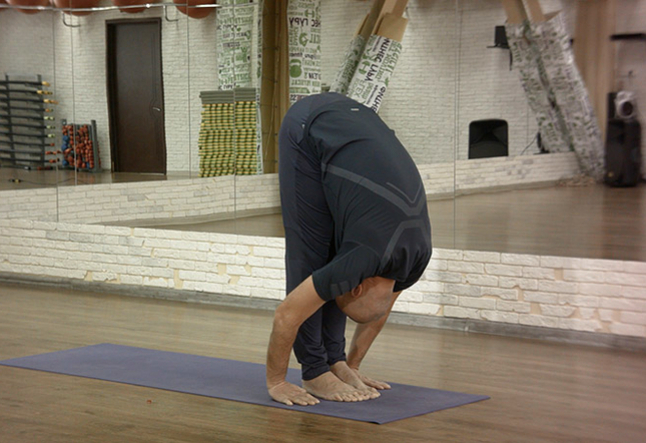
how yoga prepared me for hip replacement surgeries
In 2013 as a result of Rheumatoid Arthritis (RA), I underwent an anterior total-right-hip replacement surgery due to deterioration of the joint. I was 54 years old, and I consciously prepared for the surgery by using my yoga practice.
My practice mainly consisted of strong pranayama, bandha, and asana techniques. Up to the day of the surgery, I practiced thirty minutes of kapalabhati breath, followed by four cycles of bandha techniques(Jalandhara, Mula and Uddiyana), and one hour of asana practice. As my hip continued to deteriorate and the pain and inflammation became acute, I went from a strong ashtanga vinyasa practice to a modified sivananda practice.
Following the initial surgery, I had a successful and full recovery. Exactly two months after the surgery, I flew to India and participated in a yoga therapy teacher training course. Approximately eight to ten months after the surgery, I regained full range of motion of the hip joint and full strength and balance of the major muscle groups which were impacted by the procedure; the quadriceps, hamstrings, hip flexor muscles, and core muscles.
While the strength of the hip joint returned fairly quickly (within two months), several more months were required for the flexibility and elasticity of the hamstrings, glutes, and quadriceps to recover fully.
One month ago, I had a second anterior total hip surgery on my left hip, again due to RA. In contrast to my 2013 yoga practice, by the time I began to prepare for the 2018 surgery, I had developed a mantra and meditation practice which superseded my asana practice of earlier years.
My recovery experience is very different this time around. I have regained flexibility, elasticity, strength and balance much faster and with less discomfort. At the one month mark following surgery, I am months ahead in recovery. I believe adding the elements of mantra and a more refined meditation practice has made the difference.
At the one month mark I am
● Walking, with just a small limp
● Able to put 100% of my body’s weight solely on the left leg, and balance there for several seconds
● Able to lift the left leg up to 90 degrees, fully extended with a straight leg in front of the body and with a bent knee
● Able to extend the left leg behind me within the normal range of motion of the hip
● Able to touch my toes, uttanasana and paschimottanasana
● Able to enjoy makara adho mukha svanasana for several seconds
● Able to enjoy navasana for several seconds
● Able to enjoy janu sirsasana
● Able to enjoy virabhadrasana I and II, with precautions. Until the soft tissue has completely healed at the surgical site there is a danger of luxation when the leg is extended behind the body.
● Able to sit in dandasana for several minutes
My mantra practice, based in Vedic chanting and an evolving understanding of the powerful qualities of the Sanskrit language, has helped harmonize the dissonance within the five koshas of my body. Although imperfect, my sustained efforts at meditation have also positively affected my recovery.
I was and continue to be inspired by the writings of David Frawley. Specifically, his writings on mantra, tantra and Vedic yoga have helped guide me in my own mantra and meditation practice. Also, many of my fledgling experiences in meditation and mantra have been affirmed by the wisdom and knowledge I gained or shared while studying at the Sadhana Mandir in Rishikesh, India.
I believe the positive outcome of my surgery is largely due to my pranayama, mantra and meditation practice. These practices help harmonize my mind, body and spirit, so that the trauma of the surgery has been minimal. The recovery, from the physical body to the energy body, has been faster and more complete than my 2013 surgical experience.
For those facing anterior total hip replacement surgery, here is how I prepared for the 2018 operation
Annamaya kosha (Physical body sheath)
Strengthen major muscle groups of leg and buttocks, including hip flexors and core.
Stationary bike: twice daily 30 minutes
Virabhadrasana, I,II, III, as best as I could, given the decreased strength and range of motion of the left hip. (Warrior I,II,III)
Trikonasana (Triangle)
Parivrtta trikonasana (Revolved Triangle)
Vrksasana (Tree)
Garudasana Eagle)
Navasana (Boat)
Makara adho mukha svanasana (dolphin plank)
Series of pelvic tilts with five second inhalation and five second exhalation
Bhujangasana (Cobra)
Salamba sarvangasana (Supported shoulder stand)
Flexibility of front quadriceps, hamstrings, hip flexors
Vajrasana (thunderbolt)
Supta vajrasana Supine thunderbolt)
Supta padangusthasana (supine big toe pulling)
Various back bends, using the yoga wheel
Uttanasana (standing forward fold)
Paschimottanasana (Seated forward fold)
Balasana (Child’s pose)
Halasana (Plow)
Janu sirsasana (seated head to knee forward fold)
Parivrtta janu sirsasana (Revolved seated head to knee forward fold)
Parsvottanasana (standing intense stretch)
Upavistha konasana (seated wide angle pose)
Sukhasana (Easy sitting pose) (beneficial to core too)
Pranamaya kosha (Energy body sheath)
Ujjayi breath: 6 minutes, using a five second inhalation and five second exhalation rhythm
Kapalabhati breath: 20-30 minutes. This technique is a cleansing kriya, as well as a pranayama technique. Also, it helps to strengthen the core muscle groups and contributes to the balance of the annamaya kosha.
Anulom vilom: 10 minutes
Manomaya and Vijanamay koshas (Mind and intellect body sheaths)
Practice pratyahara, dharana, and to the best of my ability, dhyana for 30-40 minutes.
I varied these sessions by doing them in silence and at other times, listening to Vedic chants, or chanting the Maha Mrityunjaya Mantra out loud.
Mantra practice
Within my formal yoga practice and throughout the day, I silently chanted the Maha Mrityunjaya mantra as often as I could.
While awaiting surgery in the hospital I continued this chant. When my own anxiety overwhelmed me as I was waiting for the anesthesiologist, I chanted OM.
Postsurgical yoga practice
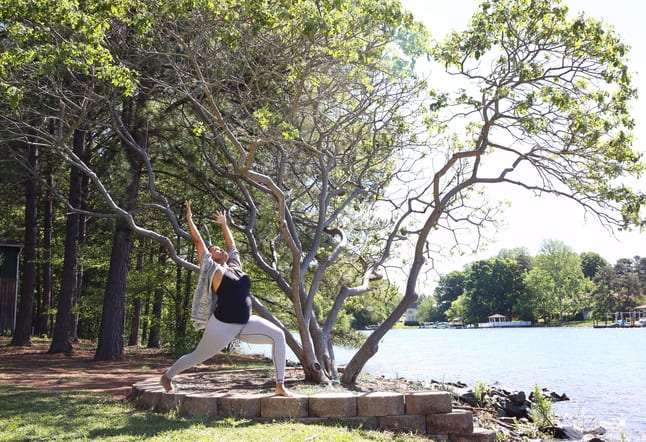
Immediately following the surgery, I began my mantra chanting practice. The sound’s vibrational frequencies, of the Sanskrit language, helped in the healing process. I also returned to a modified pranayama practice focusing more on anulom vilom than kapalbhati and ujjayi breath, at least for the first two weeks. With the help of the pranayama I practiced pratyahara, dharana and dhyana, to the best of my ability.
The first two days, I concentrated on just walking, putting more and more weight on the left leg, and performing the prescribed physical therapy movements. On the third day, I stood in tadasana, unaided, and enjoyed several deep ujjayi breaths with standing side, back, and front bends. I also was able to enjoy a modified version of virabhadrasana I.
As I enter my second month of recovery, I continue to expand and refine my yoga practice each day. I am careful to heed the instructions of my doctor and physical therapist regarding the normal cautions against luxation for anterior hip replacement surgery. I am keeping my yoga practice within those parameters for one more month. In general, I was told not to abduct or adduct the left hip until after completing two months of recovery.
I am also careful not to overstretch the hip flexors during this time. My goal this second month is to strengthen the muscles, tendons and ligaments surrounding the new hip as I explore the flexibility of those same muscle groups.
In addition to my yoga practice I am strengthening the left leg hip by riding a stationary exercise bike, gradually adding on more time to each session until I can comfortably complete a thirty- minute session. I began with ten minutes and by day thirty-two am up to twenty minutes twice daily. Here is a look at my evolving asana yoga practice as I enter the second month of recovery.
Tadasana:
My challenge is to remember to keep equal weight on both legs and keep the hips square. Before the surgery the discomfort of the hip and the shortening of the left leg caused me to tilt to the right in all my standing poses. Side, back and front bends: my challenge is to ground the feet.
Virabhadrasana I
I am careful not to extend the left leg beyond its range of motion in order to avoid luxation and to help strengthen the leg.
Padangusthasana
This is a wonderful pose to strengthen the hip flexors, lengthen the hamstrings, and engage the core.
Utkatasana
I really enjoy this pose as it offers me the opportunity to work all the major muscle groups and the core. I vary the pose by rising up onto my toes.
Uttanasana
At this stage I lower the body with my knees slightly bent and when I am all the way down I straighten them.
Vajrasana
I am able to sit comfortably in this pose, but sometimes I still feel a slight pulling sensation at the top and front of the left hip.
Janu sirsasana
My awareness is on the balance and evenness of the stretch.
Paschimottanasana
Same awareness as janu sirsasana.
Salamba sirsasana
I maintain awareness of the hip flexors and core.
Halasana
I actively engage the core as I enter and exit this pose.
Savasana
I am conscious of opening my heart in gratitude.
I continue with my pranayama, mantra, and meditation practice while sitting in vajrasana or dandasana.
I found it very useful to plan, before my surgery, how I would practice my yoga during the different months of recovery. On the yoga mat I planned how I would lower my body and rise from the mat. I knew that I could not extend the leg behind me but that it would be fine to flex the left leg and knee and sit on my heels.
I practiced kneeling, as I lowered and rose from the mat. (Vajrasana) I also strengthened my core by sitting in dandasana for long periods of time. The doctors told me I could not sit in sukhasana until after completing two months of recovery so being able to sit comfortably in dandasana allowed me to enjoy my pranayama, mantra, and meditation practices.
To depart
While we all share the same universal soul consciousness and harmony, our individual physical bodies are manifested in different ways. Your experience will be different from mine. I am sharing my story in the hope that it may help and guide others facing an anterior total-hip surgery.
Namaste
Read next >> yoga for asthma

